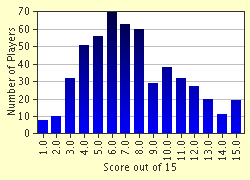Quiz Answer Key and Fun Facts
1. During which historic period was Linear B in use? Hint: this lasted from about 1400-1200 BC.
2. What material was Linear B usually written on?
3. The first Linear B tablets were discovered by Sir Arthur Evans, who was excavating what palatial site, the probable home of the mythical Minotaur?
4. After some of the Linear B tablets were published, Emmett Bennett, then a professor at Yale, performed the first step towards the decipherment of Linear B. What was this first crucial step?
5. It turned out that Linear B had approximately 90 phonetic characters, far too many for it to be an alphabet of the sort we English-speakers use, and far too few for it to be purely ideographic, like the Chinese writing system. Instead, it was probably what type of writing system, which uses one character to represent one syllable?
6. Alice Kober, a chain-smoking, very driven American scholar, discovered that some Linear B "words" had varied endings, for example (using modern conventions for transliterating Linear B characters), a-mi-ni-so / a-mi-ni-si-ja / a-mi-ni-si-jo. What is it called when a language, like the one represented by Linear B, changes word endings to indicate grammatical function?
7. The decipherer of Linear B was able to do so partly by applying the phonetic values of similar-looking signs from a related script to Linear B. On what island was this writing system used?
8. Who actually deciphered Linear B? (This individual was somewhat unusually suited for the job ...)
9. We now know the phonetic values of all the Linear B phonetic signs.
10. As it turned out, the Linear B texts did not contain spectacular works of literature. Instead, what did they record?
11. One tablet used to dramatically cinch the decipherment was a tablet from Pylos recording what?
12. What was the title of the ruler, the head guy, the "big cheese" of the Mycenaean palatial system?
13. At the time of the decipherment, nobody was expecting to find the names of gods on Linear B tablets, but they did! Some of these gods actually did not survive into the later Greek pantheon. Which of the following gods appear in Linear B?
14. The decipherment of Linear B definitively showed that this consonant was used in early Greek, although it had dropped out of use by the time of Plato. What consonant was this? For a hint, you might consider the difference between the Greek word "ergon" and its English cognate, "work."
15. Linear B's sister script has not yet been deciphered. What is the name of this sister script?
Source: Author
pu2-ke-qi-ri
This quiz was reviewed by FunTrivia editor
Beatka before going online.
Any errors found in FunTrivia content are routinely corrected through our feedback system.

